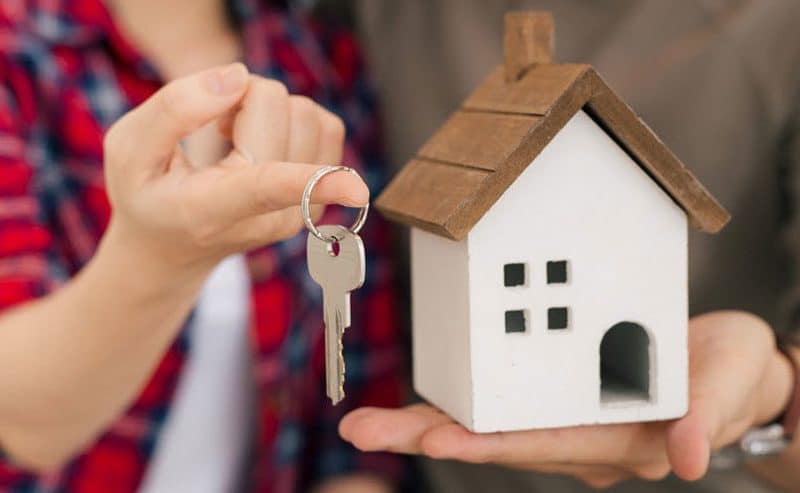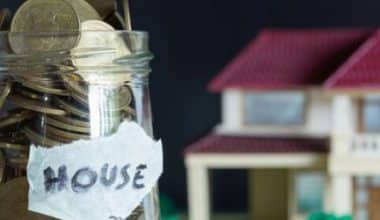If you’re like the majority of prospective homeowners, saving up for a down payment is one of your top concerns. Finding a lender that provides low or no-down-payment loans could mean the difference between being able to buy a home now and having to wait months or years. Home Loans from the government of the US Department of Agriculture or the Department of Veterans Affairs allow homebuyers to make a purchase with no down payment. The down payment on a Federal Housing Administration-insured loan might be as little as 3.5%. However, the minimum home down payment for today’s conventional loans is only 3%. When it comes to down payments and eligibility conditions, some private loan programs may hold their own against government loans. Keep reading to understand more about the types of home loans with no down payment, as a first-time buyer, and with bad credit history.
Understanding A No Down Payment on Home Loans
A zero-down mortgage is a type of mortgage in which the borrower is not required to pay any money upfront. When you get loans for a home, the first payment you make is a down payment on the house. However, most mortgage lenders will need a down payment of a certain percentage of the home’s selling price.
Say you’re purchasing a $200,000 home with a 20% down payment, which means you’ll need to bring in $40,000. After investing in the property, banks and other lenders want you to be more responsible with your loan. It might take years to save up a substantial down payment, making it a significant barrier for many prospective homeowners.
With the exception of a government-backed loan, which is insured by the federal government, major mortgage investors will not provide loans with no down payment. This means that if you default on your mortgage, the government will help pay the bills (along with your lender).
For those who might otherwise be unable to afford a home, the government now guarantees mortgages. Also, lenders can feel more comfortable extending credit to customers with riskier financial profiles, such as those who can’t afford a large down payment, when such loans are backed by the government.
Furthermore, there are two types of government-backed loans that don’t require a no down payment on a home: VA loans and USDA loans. You must meet the criteria of each lending program separately before applying for a mortgage with no down payment.
FHA loans and conventional mortgages are available if you don’t qualify for VA or USDA loans. In addition, low down payments are possible with both FHA and conventional loans.
Types of Home Loans With No Down Payment
There are two types of government-backed loan options (USDA and VA) that do not require a down payment if you qualify. Besides government programs, your local credit union, especially one based on professional membership, may offer a zero-down loan. These are uncommon but merit investigation if you come across one.
#1. VA loans
No-down-payment VA loans are available through the U.S. Department of Veterans Affairs (VA) to active-duty military members, veterans, and surviving spouses. This form of loan, like a USDA loan, does not require mortgage insurance, but it does require an upfront financing cost that can be included in the loan. (Remember that home loans do not demand a down payment, but doing so will minimize the funding charge.)
Many lenders offer lower VA loan rates than conventional loans, saving you a lot of money over the loan’s duration.
#2. USDA Loans
The United States Department of Agriculture (USDA) guarantees mortgages for people purchasing homes in rural areas. Although there is no need for a down payment when applying for a USDA loan, applicants must still meet credit, income, and other eligibility requirements. The USDA has a website where you may check your eligibility.
USDA loans require no down payment on a home, however, borrowers must pay an upfront guarantee fee that can be financed into the mortgage. If you decide to include it in your loan, you won’t have to pay anything at the outset; nevertheless, the amount you owe will increase as interest is added to the principal over the course of the loan’s term.
#3. Private Home Loans With No Down Payment
You can find loans for a home with no down payment types from private lenders as well as government-backed ones. Although no-down-payment mortgages were more common before the economic downturn of 2008, some banks still offer them.
Also, North American Savings Bank and Navy Federal Credit Union are only two examples of banks and credit unions that will grant loans with zero initial payment requirements. To join Navy Federal, a PMI is not necessary, although it is recommended. Borrowers with credit scores of 700 or better are eligible for this mortgage from NASB.
If you’re interested in this approach, talk to the lender first to gather all the information you need before applying.
What Credit Score Is Needed for a Home Loan With No Down Payment?
When applying for a conventional loan, you should aim to have a credit score that is at least 620 points high if possible. However, if your credit score is below 620, lenders will either not be able to accept your loan or will be compelled to offer you a higher interest rate, which can result in higher monthly payments. If your score is over 720, lenders will approve your loan or provide a cheaper interest rate.
First-Time Buyer Home Loans With No Down Payment
The American dream of home ownership is within reach with the assistance of first-time buyer programs.
You can use these programs to either reduce your down payment well below the industry standard of 20% or to secure a cheaper interest rate on your mortgage, saving you thousands over the life of the loan. Yes, interest rates have risen over the past few years, and home prices continue to rise defiantly. However, this does not necessarily imply that housing is unaffordable.
Types of First-Time Homebuyer Programs
The American dream has long included the fulfillment of the American dream of homeownership. As a castle, shrine, meeting place, and safe haven, the home symbolizes our freedom and independence.
Furthermore, the difficulty of breaking into a home is one of the main reasons we value ownership so highly. Homeownership is typically earned rather than given. You’ll need frugality, initiative, dependability, and self-control to earn your first set of house keys.
This is especially true now, a historically challenging moment for first-time buyers due to a lack of reasonably priced options. The average age of a first-time buyer is 32 years old, which is older than it has ever been. This is mostly due to the fact that more than 40% of first-time buyers are burdened by student debt obligations.
Hopeful homeowners are not consigned to a lifetime of substandard rents just because of this. The federal government has long encouraged homeownership as beneficial to the general welfare of the country, therefore there is much assistance available for first-time purchasers. Here are some programs for first-time buyer home loans with little or no down payment.
#1. Nonprofit Programs
If you’re a first-time homebuyer looking for a cheap mortgage, a nonprofit program may be your best bet. Low and moderate-income borrowers can get affordable mortgages from organizations like Neighborhood Assistance Corporation of America, which doesn’t charge any points or fees upfront. To do this, as opposed to the risk assessment used by other mortgage lenders, the nonprofit employs “character-based” requirements in its borrower qualification process.
Additionally, you can find community-based non-profit programs in your area. New York City’s down payment assistance program grants up to $100,000 to qualified borrowers.
#2. Conventional Loans With Low or No Initial Payments
One of the most common mortgages is a conventional loan, which is a type of credit that has no backing from the government and hence has fewer restrictions on who can apply for it. Furthermore, some of them require an incredibly small down payment of only 3% of the home’s purchase price.
Fannie Mae and Freddie Mac regulate the terms of borrowing for conventional mortgages. These packages consist of:
- HomeReady mortgage: Fannie Mae’s HomeReady mortgage program is similar to Freddie Mac’s in that it only necessitates a 3% down payment (with PMI, however, it could be cheaper).
- Conventional 97 mortgages: Conventional 97 is supported by Fannie Mae and Freddie Mac and takes only 3% down and a credit score of 620. Private mortgage insurance (PMI) is an extra fee that is added to the monthly mortgage payment in the case of standard low-down-payment mortgage programs.
- HomeOne mortgage: This Freddie Mac mortgage requires only a 3% down payment with PMI, however, it is restricted to first-time buyers and has other requirements.
When applying for one of these mortgages, you won’t be dealing with Fannie Mae or Freddie Mac directly. Instead, you can find them through a wide variety of financial institutions like banks, online mortgage lenders, and credit unions.
#3. Employer-Sponsored Programs
When it comes to finding a place to live, many workers might benefit from employer-assisted housing (EAH) programs, which are typically located in or near the workplace. One type of aid is a loan that is forgiven after a certain number of years, along with mandatory homeownership classes. There may be other requirements for EAH programs than the occupation requirement, such as being a first-time homebuyer, a tenure requirement, or an income cap.
What Is the Lowest Possible Down Payment on a House?
A 3% down payment might be achievable, though, depending on the type of loan and the buyer’s credit. It’s possible that if you qualify for a USDA loan or a VA loan, you won’t need any down payment at all to buy a house. The required initial payment varies among various loan programs.
Bad Credit Home Loans With No Down Payment
For the vast majority of people, a home represents their single largest financial investment. However, many people, especially those who lack savings or have bad credit, may feel like buying a home is out of their reach. Unfortunately, there is currently no viable option for a home buyer with bad credit and no down payment. There may be solutions available to assist you buy a home even if you have good credit but low savings.
The possible range of a credit score is 300 to 850. While creditworthiness requirements vary from one lender to the next, the ranges in which they look at a borrower’s credit history are fairly consistent.
One of the most prominent credit agencies in the United States, Experian, provides the following breakdown of credit score brackets:
- 300 – 579: Poor
- 580 – 669: Fair
- 670 – 739: Good
- 740 – 799: Very Good
- 800 – 850: Exceptional
While the vast majority of loan providers require borrowers to have excellent credit, there are a few options available to those with fair credit as well. For instance, buyers with credit scores of 580 and above can qualify for an FHA loan that requires only a 3.5% down payment.
Keep in mind that these are just ballpark figures and that each FHA lender can set their own additional standards for FHA mortgages.
Can You Buy a House with Bad Credit?
Although it is possible to purchase a home with poor credit, you should not expect to pay rock-bottom prices. It is possible to buy a home with bad credit through some programs, such as FHA loans. However, a larger down payment will be required if your credit score is below 580.
People with credit scores under 580 are required to put down 10% on an FHA loan, which is significantly more than the 3.5% needed by those with higher scores. A conventional loan has stricter requirements.
If you want a mortgage and have a low credit score, you’ll need a larger down payment and will have to agree to pay a considerably higher interest rate. Your loan’s interest rate will determine both your monthly payment and its total cost. Also, read HOW TO BUY A HOUSE WITH NO MONEY: For First-Time Buyers.
If you borrow $200,000 over 30 years at 3% interest, your mortgage payment will be $843 per month. The entire cost of the loan during its full term of 30 years is $303,555.
With an interest rate of 5%, the same loan would set you back $1,074 monthly or $386,512 over the life of the loan, an increase of about 27%. Inadequate ratings can result in even higher interest rates.
What Credit Score Do You Need For $0 Down?
In most cases, loan providers would not reveal their minimal credit score demand. They also take into account the applicant’s debt load, payment history, and timeliness of bill payments, all of which can affect their credit score.
Someone with a bad credit score may have a better chance of securing a car or home loan with no down payment if they have a favorable payment history and a trade-in vehicle, for example than someone with numerous late payments but other circumstances that give them a higher credit score.
A down payment is typically needed for a home or car loan, but not for a personal loan. People who have a bad credit score can often get approved for no-down-payment loans from the lending platforms and banks that we’ve suggested. It may be more challenging to qualify for a mortgage loan if your credit score is poor.
The online lending networks we recommend offer terrible credit auto loans with no down payment required for borrowers with FICO scores between 500 and 579, which is considered very poor.
The possible values for a FICO credit score are 300 to 850. If your credit score is below 500, you may find it difficult to secure a car or home loan from traditional lenders. A low credit score may be overridden, though, by a substantial down payment or reliable cosigner.
Financing costs are often higher for those with lower credit ratings. Because of this, it is important to compare financing options.
Best Lenders for Low- and No-Down-Payment Home Loans
Rising home prices and interest rates have made it challenging for many borrowers to enter the housing market. Fortunately, there are options available from some lenders that can help would-be homeowners with both their down payment and their closing costs. Here are the top 3 lenders for low or no down payments on home loans.
#1. Bank of America
Bank of America’s Better Money Habits and First-Time Homebuyer Online Edu-Series programs are two examples of the company’s dedication to helping the next generation of homeowners. Borrowers can reach out to the company’s loan teams via the company’s website, by phone, or in person, whatever is most convenient for them.
Furthermore, Bank of America also topped the list because of the range of first-time buyer loan packages it provides, such as the Affordable Loan Solution mortgage, which only calls for a 3% down payment.
In addition to the Affordable Loan Solution mortgage, Bank of America has a Down Payment Grant program where qualified borrowers can receive up to $10,000 or 3% of the home’s purchase price as a down payment. There is no need to pay back a grant.
Preferred Rewards mortgage customers can save up to 0.375% on their interest rate and get a discount on their loan origination charge if they keep a certain amount in a Bank of America deposit account and/or Merrill Edge and Merrill Lynch investment account.
#2. Rising Bank
Rising Bank, the online division of Midwest BankCentre, a St. Louis-based bank, is the best option for borrowers seeking a convenient, community-minded online mortgage application process. A representative of Rising Bank described the bank’s method as “high tech/high touch,” explaining that the company caters to customers who want an automated, expedited mortgage procedure while simultaneously placing a premium on a human touch.
In addition to the usual assortment of government-backed mortgages, Rising Bank also provides conventional loans with as little as a 3% down payment. For borrowers who cannot provide standard documents for a home loan, the Midwest BankCentre government offers no down payment loans and Individual Tax Identification Number (ITIN) mortgages through its channel. The DPA programs are available through both distribution methods.
Borrowers that place a premium on quick processing times may choose to consider Rising Bank. According to a representative from Rising Bank, the average time it takes to close on a mortgage loan is 21 days, though this number can be as low as seven for certain loans.
#3. Chase
Chase Home Lending has a number of loan options available to help more people realize the American dream of homeownership.
Homebuyers with incomes below a particular threshold can qualify for Chase’s special Chase DreaMaker mortgage, which is available in addition to VA and FHA loans. The minimum down payment is 3% and there is a $500 credit for completing a homebuyer education course (mandatory for first-time buyers) with this financing.
Chase’s partner HomeStory offers borrowers an incentive of up to $5,000 if they use the Chase Agent Express program to find a real estate agent.
Additionally, Chase offers homebuyers who qualify a $2,500 or $5,000 credit toward closing costs, interest, or a down payment on certain loan products through the Chase Homebuyer Grant. When applying for a VA loan with Chase, qualified service members may also be eligible for a $2,000 VA Purchase Closing Cost Grant.
The loan closing process will be easy no matter which option you go with. If closing doesn’t take place within three weeks, Chase will pay qualified borrowers $5,000.
How Much Is a Downpayment on a 400K House?
10% of the purchase price is $40,000, therefore the down payment for a $400,000 home would be $55,600. Your monthly income must be at least $8,200 if you want to qualify for a 30-year mortgage, and your total monthly debt payments must not be more than $981.
Can You Borrow Money for a Down Payment?
Yes, you can borrow money to use as a down payment. Borrowing against the equity of another property is one of the various lending options that can be explored to cover a down payment. Seek personal loans from family and friends.
Conclusion
As home prices continue to rise, many potential buyers will find it challenging to save up the traditionally recommended 20% down payment. Don’t let the thought of needing an enormous number of money to buy a property put you off. Depending on the program, you may be able to put zero or a very small amount down on a home. Examine the market from the perspective of several different loan providers. Shopping around for a mortgage will help you get the greatest rate that works with your finances.
FAQs
How much is a downpayment on a 500k house?
A down payment of at least $17,500 is necessary on a home that costs $500,000 to purchase.
How much is a downpayment on a 200k house?
A minimum of 5% down is usually necessary for conventional mortgages, such as the standard 30-year fixed-rate mortgage. In this example, you’ll need a down payment of $10,000 on a home that costs $200,000 to finance the purchase.
Similar Articles
- BEST FIRST CREDIT CARD FOR BEGINNERS IN 2023
- NEW HOMEOWNERS TAX CREDIT: What It is And The Eligibility
- BEST FIRST CREDIT CARDS 2023
- No Down Payment Mortgage: Getting a Mortgage With No Down Payment In 2023
- HOW MUCH SHOULD I BE SAVING: Savings Amount for Taxes, Retirement, Each Month & @ 30






